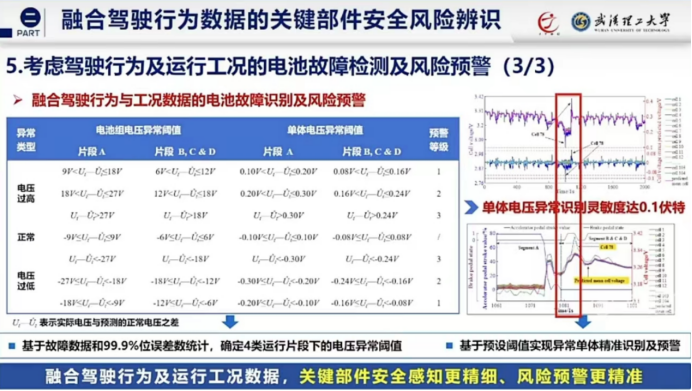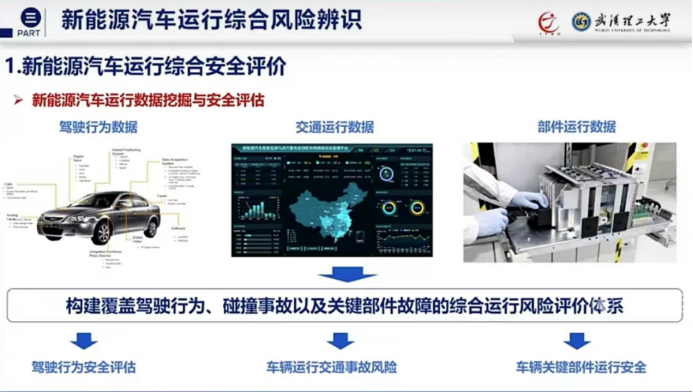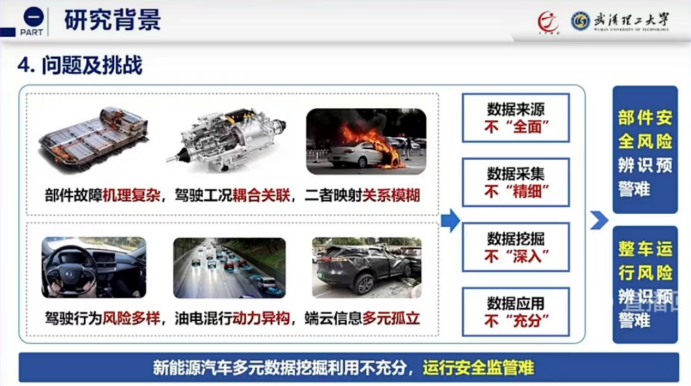Author: Lingfang Wang
Editor: Kaijun Qiu
13 million cars, 400 billion kilometers driven, 61 reported data points – these are the achievements of China’s National Big Data Platform for New Energy Vehicles (referred to as the Big Data Platform) in the six years since its establishment.
Matching China’s leading position in the global new energy vehicle market, China has established the world’s only national vehicle-to-vehicle network for new energy vehicles.
Through data access, statistics, and analysis of new energy vehicles, the Big Data Platform supports policy making, industry management, standard development, technical research, and scenario analysis for new energy vehicles.
One specific application of the Big Data Platform is to support the safety of new energy vehicles.
For example, there is controversy in the industry about whether new energy vehicles are safer or more dangerous than traditional fuel vehicles.
According to Sun Fengchun, academician of the Chinese Academy of Engineering and professor at Beijing Institute of Technology, the safety accident rate for new energy vehicles is slightly lower than that of traditional fuel vehicles. According to data from the Public Security Department, the accident rate for traditional fuel vehicles is between one in ten thousand to two in ten thousand, while the rate for new energy vehicles is currently below one in ten thousand.
However, another set of data provided by Wu Chaozhong, vice president of Wuhan University of Technology, is concerning. “Using 2020 data as an example, the accident rate per ten thousand vehicles for new energy vehicles is 12.47%, while for traditional fuel vehicles it is only 5.51%. The death rate per ten thousand vehicles for new energy vehicles is 2.1%, while for traditional fuel vehicles it is only 1.46%.”
Combining the two sets of data, we might conclude that while the fire rate of new energy vehicles is lower than that of traditional fuel vehicles, the accident rate is not lower, and once an accident occurs, the severity is much higher than that of traditional fuel vehicles. Of course, this conclusion is mainly limited to the period before 2020, and as more and more new energy vehicles hit the road, with richer data monitoring, more comprehensive conclusions will be possible.
Currently, the real-time monitoring data provided by the Big Data Platform has already provided rich data support for researching the mechanisms of new energy vehicle accidents.
At the China New Energy Vehicle Big Data Industry Conference held in Shenyang on March 19, 2023, experts offered suggestions on improving the accuracy of data early warning, improving big data, and strengthening regulation.The core message of the industry conference is that the big data platform, which has been established for six years, is further improving its capability in data access, statistics and analysis, expanding the application space of the platform, and striving to provide better data services for the most concerned safety issues in the whole society.
Access to 13 million new energy vehicles
The big data platform plays a vital role in the data supervision of new energy vehicles.
Under the guidance of the Ministry of Industry and Information Technology, the National Supervision Platform for New Energy Vehicles was established in 2017. As of March this year, the platform has accumulated over 13 million new energy vehicles with monitoring data covering 61 items. The supervision platform has made remarkable achievements in new energy vehicle quality management, safety control, and social support system construction.
The amount of cumulative data access is huge. According to Sun Fengchun’s introduction, the big data platform’s data volume per day is close to 50 to 100 terabytes. Up to now, the new energy vehicles that have been accessed by the big data platform have accumulated more than 400 billion kilometers, which is approximately 500 to 600 million kilometers per day, resulting in approximately 150 million tons reduction in energy consumption and carbon dioxide emissions (excluding carbon dioxide emissions from power generation).
During the Winter Olympics and the 100th anniversary of the Communist Party of China, the big data platform conducted real-time safety monitoring and supervision on key vehicles, making important contributions to ensuring the stable operation of vehicles.
Providing data support for research structure. In fact, through the big data platform, characteristics of new energy vehicle markets, vehicle operation, and charging can be analyzed. By summarizing these features and suggesting development proposals, they have certain reference value and guiding significance for relevant government departments, research institutions, universities, and enterprises.
The complex mechanism of new energy vehicle component failures
Compared with fuel vehicles, new energy vehicles have a relatively low maturity rate, so safety issues have always been the focus of industry professionals and consumers.
From the data provided by Wu Chaozhong, the growth rate of new energy vehicles is rapid, and the accident rate is growing even faster. As of January this year, the number of accidents involving new energy vehicles has increased by 171% compared with the same period last year while the number of deaths has increased by 157%. From 2018 to 2020, China has experienced 9,780 accidents involving new energy vehicles, resulting in 1,717 deaths.Based on the big data platform, Wu Chaozhong conducted in-depth research on accidents of new energy vehicles.
In Wu Chaozhong’s view, there are mainly two types of accidents for new energy vehicles: First, accidents caused by the car itself-thermal runaway, which is mainly related to the battery; Second, accidents caused by the new energy vehicle in traffic, which is closely related to the driving environment and driving behavior characteristics.
Wu Chaozhong believes that the mechanism of component failure in new energy vehicles is quite complicated, and it is related to driving conditions, but the relationship between them is not yet very clear. In addition, new energy vehicles are also related to road environment, hybrid power, and power heterogeneity during driving.
From the perspective of components, Wu Chaozhong’s research has found that there is some connection between the thermal runaway accidents of the battery and driving behaviors. For example, the travel of the accelerator pedal affects the current and speed of battery discharge; the travel and deceleration of the automatic pedal affect the current of energy feedback and the voltage size. In addition, the duration of driving also brings about a rise in battery temperature and voltage fluctuations.
In order to conduct this research, Wuhan University of Technology has set up corresponding experiments: 20 electric vehicles have conducted 10 months of natural driving experiments, collecting data from vehicle working conditions, motor working conditions, battery data, driving behaviors, driving conditions, traffic environment, etc. “We have reached 60TB of data, of which structured data alone is 5TB,” said Wu Chaozhong.
Based on this data, Wu Chaozhong conducted several aspects of mining and analysis.
Firstly, the coupling relationship between driving behavior data and battery safety was analyzed. First, they marked the driving behavior into four segments: A segment is when the accelerator pedal is stepped on; B segment is when the accelerator pedal naturally decelerates; C segment is when the brake pedal is depressed, and D segment is when the pedal is released for automatic deceleration.By analyzing the chart data, a close relationship between each driving segment and battery voltage can be observed. Through data mining, it was found that under the KW test, the standard deviation of battery voltage is significantly affected by the travel distance of the accelerator pedal, the travel distance of the brake pedal, and the speed. In addition, in this micro-segment, the travel distance of the accelerator pedal and the speed are the main factors affecting the voltage domain of the battery.
Secondly, Wuhan University of Technology conducted a coupled analysis of driving traffic environment and battery safety. According to the categories of congestion, normal, and smooth traffic, 16,177 segments of effective movement were identified. 24 related feature parameters were proposed for each segment, covering vehicle speed, pedal and driving behavior, and some information on road traffic.
Wuhan University of Technology conducted multi-dimensional and multi-time data extraction and mining, and found that the maximum speed, average driving speed, and the standard deviation of speed have a high correlation with the voltage domain, all exceeding 0.8.
Data shows that the consistency of battery voltage of new energy vehicles is the worst under high-speed conditions, and the consistency of battery voltage is also the worst at 60% to 80% remaining battery capacity.
Wu Chaozhong combined driving behavior, driving conditions, battery fault detection, and risk warning to predict when the risk of battery failure is most likely to occur in new energy vehicles.
Wuhan University of Technology established a model for these correlation relationships, combining behavior feature parameters and operating conditions, and using a neural network model to predict battery voltage. Through this method, Wuhan University of Technology reduced the average error of battery prediction by 65%.
Based on fault data and statistical analysis of micro-errors of 99.9%, Wuhan University of Technology identified abnormal voltage values in four operating segments, that is risk prediction. The sensitivity of identification can reach 0.1V, achieving more precise perception of critical components and more accurate risk warning.
In addition to conducting a comprehensive risk assessment from the perspective of new energy vehicle operation, Wuhan University of Technology has also integrated driving behavior and traffic operation data to form a comprehensive risk assessment system.

Furthermore, they conducted a risk analysis of new energy vehicles and fuel vehicles at different penetration rates. By building micro traffic simulation scenarios, they evaluated the safety risks of vehicle operation with a safety substitution method. The conclusion drawn is that under mixed traffic conditions, there are differences in safety risks for new energy vehicles at different penetration rates.
For example, the safety risks of new energy vehicles are continuously increasing during the 0-30\% penetration rate period, and then gradually decreasing during the 30\%-100\% stage.

The technology level of platform monitoring and overall efficiency needs to be improved urgently
During data analysis, Wu Chaozhong also found many data problems, such as incomplete data sources, imprecise data collection, insufficient data mining and inadequate data application.

Wu Chaozhong believes that these problems increase the difficulty of component safety warning and new energy vehicle operation risk identification.
To address this, Wu Chaozhong made several recommendations. Firstly, collect data based on a more refined and granular level, and expand the functionality of the national new energy vehicle regulatory platform.
Secondly, integrate advanced artificial intelligence technologies, such as group mining, graph mining, and semantic mining, to expand the application scenarios for safety supervision.Thirdly, further integration of digital twin technology and holographic perception technology is needed to achieve comprehensive monitoring and management of the safety of new energy vehicles and other vehicles in mixed traffic conditions.
At the meeting, Wang Zheng, Senior Engineer of the Supervision and Management Department of the Equipment Center of the Ministry of Industry and Information Technology, also mentioned the problems of data collection.
Wang Zheng also believes that the overall efficiency of platform monitoring technology needs to be improved urgently. Regarding the monitoring platform, some enterprise platform data is not smooth, closed-loop or interconnected, and the monitoring efficiency is relatively low. “In terms of the disposal of relevant information for level-three alarms on this monitoring platform, it must be closed-loop for all level-three alarms, otherwise there will be safety risks.”
In terms of safety warning, the research on safety warning technology for new energy vehicles in some enterprises is still in its infancy, and it does not yet have the ability to provide safety warnings for the entire vehicle.
Wang Zheng believes that the current emergency response mechanism for accidents is not perfect and the disposal capacity is relatively weak. For major disasters, some enterprises mainly rely on passive emergency rescue, lack proactive emergency response mechanisms, overall coordination, and there is a lack in terms of comprehensive management.
In addition, Wang Zheng also mentioned that after most enterprises experienced fire accidents, they had varying degrees of failure to report the fire accidents in a timely manner according to the requirements, and there were incidents of omission and belated reporting. “In fact, we have been connected with the Emergency Management Department in the early stages, and our data is quite different from theirs. Their data is actually realistic, so there are incidents of belated and omitted reporting in our enterprises.” Wang Zheng reminds that there are clear regulations on this part, and if the enterprise cannot comply, they will be punished accordingly.
It can be seen that improving the safety of new energy vehicles is traceable, and a complete big data platform is the foundation. Only by continuously improving big data can researchers further explore the connections between data, improve the accuracy of safety warnings, and ultimately effectively enhance the safety of vehicles, empowering the development of new energy vehicles.
This article is a translation by ChatGPT of a Chinese report from 42HOW. If you have any questions about it, please email bd@42how.com.
